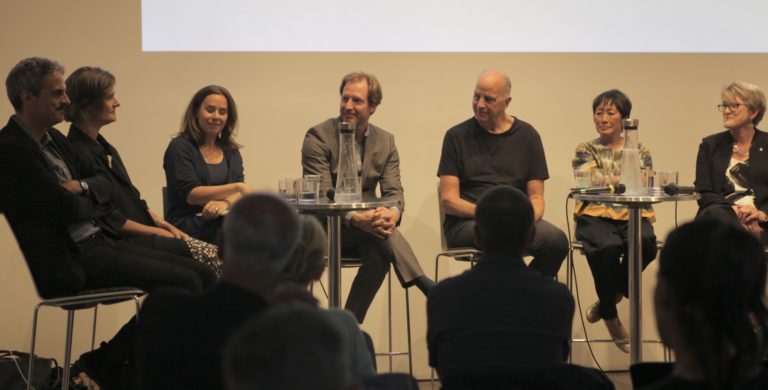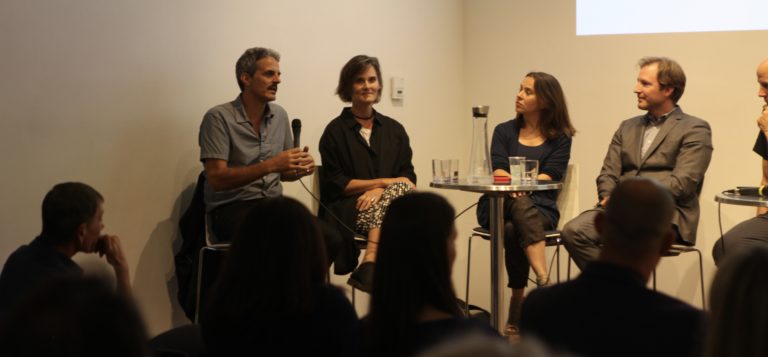-
September 18, 2020Work/Family Crisis: Covid-19

Dear Colleagues,
One year ago, Namita Modi and I launched this knowledge committee with a panel discussion held at the Center for Architecture titled The Architect’s Challenge: Work/Family Balance. Who could ever imagine a time when the majority of New York City architects would be required to work from home to limit the spread of a deadly disease? The working conditions that Americans are enduring because of COVID-19 are so stressful that the US Centers for Disease Control and Prevention have created a dedicated webpage to offer advice on how to recognize what stress looks like, take steps to build resilience, and know where to go if you need help. Learn more here.
One year ago, we invited architects and residential designers—Jane Frederick, Hayes Slade, James Slade, Sofia Zimmerman, Adam Zimmerman, Billie Tsein, and Tod Williams—who are design partners with their spouses to have a conversation regarding work/family balance. We were so pleased with the results and felt that there was an uplifting take-away that we should share with our colleagues during these trying times. Throughout their careers, all endured work crises and family crises—as all architects do. Yet, the entire conversation circled around the joy of architecture, the joy of dedicating their life to their vocation, and the joy of engaging their family—their spouses, their children, and parents—in their work. Perhaps, none would be able to be as single minded about their seemingly endless capacity to achieve a happy work/family balance if we held the conference today; but, the summary below, which was written soon after the panel discussion, explains how they felt back then and we felt it was worth sharing again.
Namita and I hope everyone gets the help they need to be as safe and sound as the possibly can be during these trying times.
Best Regards,
Dennis WedlickAIANY CRAN Review of the September 18, 2019 The Architect’s Challenge: Work/Family Balance,—a frank discussion with practitioners who co-own architecture firms with their spouses, written by Dennis Wedlick, co-chair of AIANY CRAN. (Written 9/25/2019 by Dennis Wedlick.)
Residential architects and their loved ones know that practices like ours require the business owners to work all hours of the day, all days of the week, and all weeks of the year. Spouses, children, parents, siblings, and friends all experience firsthand our round-the-clock workload: Builders reach out to us in the morning and late evening, while vendors, consultants, and colleagues keep us busy all during the day, and then clients have us going well into the night, on weekends, and even during holidays. Our collective experiences caring for our families and other loved ones while tending to the 24/7 needs of our businesses translates to a challenge that can threaten our abilities as both caregivers and practitioners. Those personal experiences—trying to give equally to our practices and our loved ones—inspired the idea for the panel discussion entitled “The Architect’s Challenge: Work/Family Balance.”

The Panelists: (Left to right) Hayes Slade, James Slade Sofia Zimmerman, Adam Zimmerman, Billie Tsein, and Tod Williams, and Jane Frederick.
Why hold a panel discussion on work/family balance specifically with practitioners who co-own their architecture firms with their spouses?
At AIANY events and AIA national conferences and symposiums, between sessions about best professional practices, the conversation among architects who own a small practice quickly turns from work to more personal matters—such as getting children into good schools, providing resources for aging parents, or helping a disabled friend get the support he/she needs. Once my co-chair Namita Modi and I decided to hold a panel discussion to address this challenge of work/family balance, we needed to determine who to invite to participate. Although all architects face work/family challenges, we decided to specifically host a conversation between architects who own practices with their spouses. Why? Two reasons: Firstly, all the panelists would be in a similar situation—an apples-to-apples comparison of one type of practitioner—one who co-owns a practice with their spouse—experiences work/family balance. Secondly, we assumed that architects who co-owned their practice with their spouse might find work/family balance doubly challenging when compared to architects whose business partner was not their spouse because both business owners would be dealing with the exact same work/family needs at the same time. We thought this particular set of panelists would highlight for the audience the work/family challenges that are unique to the practice of architecture.

Panel moderator Dr. Lois Oppenheim.
Through a jovial, thought-provoking conversation led by Dr. Oppenheim, the panelists offered a plethora of tried-and-true ideas for minimizing the challenges of balancing work and family needs.
As we all experienced on September 18, 2020 at the Center for Architecture, simply by answering questions about their work and their personal lives offered to them by Dr. Oppenheim—a skilled, probing, and engaging moderator—the panelists, Jane Frederick, Hayes Slade, James Slade, Sofia Zimmerman, Adam Zimmerman, Billie Tsein, and Tod Williams shared a frank presentation of the day-to-day story of their business and family life. To my surprise and delight, the panel discussion highlighted tried-and-true ideas for achieving work/family balance. They offered a plethora of positive experiences and thoughtful reflections about balancing work and with family needs that all can learn from. They did so jovially, humbly, without an agenda or aim. Their stories relay a career being immersed in their work 24/7, having their family fully integrated into their work lives, and knowing that working hard at architecture was a shared adventure of the whole family. Treasured stories about raising children, caring for aging parents, and working together—all the time—were told consistently as examples of why they love their chosen career paths.

AIANY CRAN Work/Family Balance at the Center for Architecture in Fall of 2019.
An unexpected takeaway: Comfortably blending your work life into your family life might be less stressful than trying to divorce the two.
When we listen to the conversation, we heard thoughts that may be unique for these panelists who co-own their practice with their spouses but may be useful takeaways for all architects. As an example, the panelists confirmed that their work life was entirely blended into their family life, and that was not only okay, but a good thing for all of them. Once it was explained, it was obvious to me how challenging it was for me to divorce my work life from my family life, particularly because residential architecture is a 24/7 business. Because my spouse was not my business partner when a call came in on the weekends, or I spent evenings thinking about a design problem, I would worry that my work was taking time away from being with family. And, when my business partner was called home for an unexpected family matter, he worried that his family was taking him away from the work that needed to be done. This is what leads to a feeling of imbalance that the married-to-their-partner panelists avoid because they share in everything: work and family. Therefore, one takeaway for me was: While challenging, maybe helping your family feel at home with your 24/7 work may be less stressful than trying to divorce them from your business, your passion. The panelists make it clear that architects cannot be their best possible selves—enjoying a happy family life while pursuing a successful business—if they feel pressured to compromise one for the other.

AIANY CRAN Work/Family Balance After Party at the Center for Architecture in Fall of 2019.
Conclusion: By sharing in conversations about work/family balance, we can learn from each other’s experiences. We encourage our fellow architects to continue these important discussions about our social well-being as a community of design professionals who are frequently under considerable stress and anxiety because of the challenges we face in our chosen profession.
We at AIANY CRAN are so grateful to all who participated, and we hope it will inspire future events to explore the work/family balance challenges that we all face.
Committee on Residential Architecture
The Committee on Residential Architecture (formerly known as the Custom Residential Architects Network) was established in 2019 to allow the AIANY community and the public to share in the knowledge and experiences gained when exploring the realm and context of the privately owned home. The customized design and construction of private residences significantly impacts other building typologies by sparking innovations in methods, means, and materials. Our professional development programming focuses on storytelling, because the personal narrative is often the driving force behind the specialized practice that accompanies these unique design commissions.







